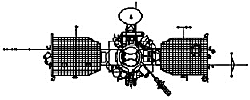
Mars 96 Orbiter
NSSDC ID: 1996-064A
Description
The Mars 96 spacecraft was launched into Earth orbit, but failed to achieve insertion into Mars cruise trajectory and re-entered the Earth's atmosphere at about 00:45 to 01:30 UT on 17 November 1996 and crashed within a presumed 320 km by 80 km area which includes parts of the Pacific Ocean, Chile, and Bolivia. The cause of the crash is not known.
The Russian Mars 96 mission was designed to send an orbiter, two small autonomous stations, and two surface penetrators to Mars to investigate the evolution and contemporary physics of the planet by studying the physical and chemical processes which took place in the past and which currently take place. The Mars 96 Orbiter was a 3-axis sun/star stabilized craft based on the Phobos design with two platforms for pointing and stabilizing instruments. The propulsion units were mounted on the bottom and two large solar panels extended out from opposite sides of the craft. The two penetrators were mounted on the bottom by the propulsion system, the two small stations were connected on top of the spacecraft, and a dish antenna extended off one of the sides perpendicular to the solar panels. The Mars 96 spacecraft had a launch mass (including propellant) of 6180 kg.
Mars 96 was scheduled to arrive at Mars on 12 September 1997, about 10 months after launch, on a direct trajectory. About 4 to 5 days before arrival the small surface stations would have been released. The orbiter was to go into an elliptical 3-day transfer orbit about Mars, and the two penetrators to descend to the surface during the first month of orbit. The final orbit would have been a 14.77 hour elliptical orbit with a periapsis of 300 km.
The Mars 96 Orbiter carried 12 instruments to study the surface and atmosphere of Mars, 7 instruments to study plasma, fields, and particles, and 3 instruments for astrophysical studies. There were also radio science, a navigation TV camera, and a radiation and dosimetry control complex. The instruments were located directly on the sides of the craft, on one of the two platforms attached to the sides of the craft, or on the edges of the solar panels.
Facts in Brief
Launch Date: 1996-11-16
Launch Vehicle: Proton-K
Launch Site: Tyuratam (Baikonur Cosmodrome), Kazakhstan
Mass: 3159.0 kg
Funding Agency
- Russian Space Agency (Russia)
Discipline
- Planetary Science
Additional Information
- Launch/Orbital information for Mars 96 Orbiter
- PDMP information for Mars 96 Orbiter
- Telecommunications information for Mars 96 Orbiter
Experiments on Mars 96 Orbiter
Data collections from Mars 96 Orbiter
Questions or comments about this spacecraft can be directed to: Dr. David R. Williams.
Personnel
| Name | Role | Original Affiliation | |
|---|---|---|---|
| Dr. Albert A. Galeev | Program Scientist | Russian Academy of Sciences | agaleev@iki.rssi.ru |
| Dr. Alexander V. Zakharov | Project Scientist | Russian Academy of Sciences | zakharov@iki.rssi.ru |
Selected References
Galeev, A. A., Russian program of planetary missions, Acta Astronautica, 39, No. 1-4, 9-14, 1996.
Mars 96 Failure -
Timeline from launch to re-entry
Mars 96 Surface Station
- from the NSSDC Master Catalog.
Mars 96 Penetrator
- from the NSSDC Master Catalog.

